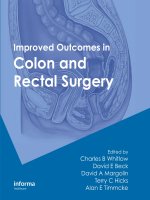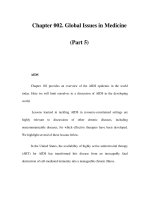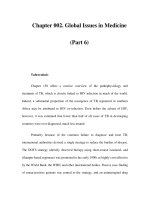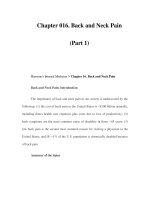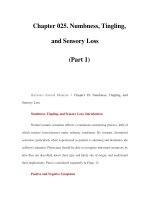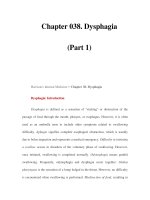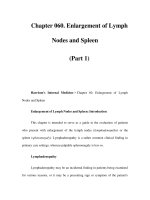Endourooncology New Horizons in Endourology - part 1 ppsx
Bạn đang xem bản rút gọn của tài liệu. Xem và tải ngay bản đầy đủ của tài liệu tại đây (170.51 KB, 18 trang )
Recent Advances in Endourology, 6
H. Kumon, M. Murai, S. Baba
(Eds.)
Endourooncology
New Horizons in Endourology
Recent Advances in Endourology, 6
H. Kumon, M. Murai, S. Baba
(Eds.)
Endourooncology
New Horizons in Endourology
With 53 Figures
Hiromi Kumon, M.D., Ph.D.
Professor and Chairman, Department of Urology
Okayama University Graduate School of Medicine and Dentistry
2-5-1 Shikata, Okayama 700-8558, Japan
Masaru Murai, M.D., Ph.D.
Professor and Chairman, Department of Urology
Keio University School of Medicine
35 Shinanomachi, Shinjuku-ku, Tokyo 160-8586, Japan
Shiro Baba, M.D., Ph.D.
Professor and Chairman, Department of Urology
Kitasato University School of Medicine
1-15-1 Kitasato, Sagamihara, Kanagawa 228-8555, Japan
ISBN 4-431-21389-9 Springer-Verlag Tokyo Berlin Heidelberg New York
Library of Congress Control Number: 2004113089
Printed on acid-free paper
© The Japanese Society of Endourology and ESWL 2005
Printed in Japan
This work is subject to copyright. All rights are reserved, whether the whole or part of the material
is concerned, specifically the rights of translation, reprinting, reuse of illustrations, recitation, broad-
casting, reproduction on microfilms or in other ways, and storage in data banks.
The use of registered names, trademarks, etc. in this publication does not imply, even in the absence
of a specific statement, that such names are exempt from the relevant protective laws and regula-
tions and therefore free for general use.
Product liability: The publisher can give no guarantee for information about drug dosage and appli-
cation thereof contained in this book. In every individual case the respective user must check its
accuracy by consulting other pharmaceutical literature.
Springer is a part of Springer Science+Business Media
springeronline.com
Typesetting: SNP Best-set Typesetter Ltd., Hong Kong
Printing and binding: Shinano Inc., Japan
SPIN: 10997055 series number 4130
Preface
The trend in all surgical disciplines has been toward nonoperative or minimally
invasive treatment. Endourology, which began with the development of cys-
toscopy, now encompasses all minimally invasive techniques including urologic
laparoscopy, creating new horizons in endourology. Endourooncology, the
merging of endourology and oncology, is one of the most challenging and rapidly
evolving areas in urology practice and will revolutionize our approach to uro-
logic malignancies with continuing refinements in technique.
Recent Advances in Endourology, volume 6, one of a series of publications
organized by the Japanese Society of Endourology and ESWL, focuses on
endourooncology and related topics. For the treatment of urologic malignancies,
advanced and sophisticated reconstructive procedures increasingly have been
performed purely laparoscopically. In the near future, standardized procedures
will be conducted by robotic systems with advanced surgical eyes and hands. A
more important role of robotic systems will be to open new vistas for telemen-
toring and telerobotic cancer surgery, providing a novel educational system in
order to overcome the steep learning curve faced by inexperienced surgeons. In
addition, a variety of energy-based, targeted technologies, including radiofre-
quency ablation, high-intensity focused ultrasound (HIFU), and cryoablation are
being investigated intensively for the treatment of localized urologic cancers.
These image-guided targeted therapies will become preferred options as early
detection methods for localized cancers develop, as in the case of transperineal
brachytherapy for prostate cancer. Similarly, image-guided in situ gene therapy
will have a great impact on future endourooncology.
We editors are most grateful to the authors for contributing excellent, infor-
mative review articles. We believe that these thirteen articles will enable the
reader to envision future horizons in endourooncology. In the future, we will be
able to offer each patient the most beneficial, tailor-made procedure that will
provide lower morbidity, less pain, shorter hospital stay, and excellent cosmesis
as well as a favorable long-term oncological and functional outcome.
Hiromi Kumon, M.D., Ph.D.
Chief Editor
V
Contents
Preface . . . . . . . . . . . . . . . . . . . . . . . . . . . . . . . . . . . . . . . . . . . . . . . . . . . V
Contributors . . . . . . . . . . . . . . . . . . . . . . . . . . . . . . . . . . . . . . . . . . . . . . . IX
Merging of Endourology and Oncology: Endourooncology
A. El-Hakim, B.R. Lee, and A.D. Smith . . . . . . . . . . . . . . . . . . . . . . . 1
Surgical Robots and Three-Dimensional Displays for
Computer-Aided Surgery
T. Dohi . . . . . . . . . . . . . . . . . . . . . . . . . . . . . . . . . . . . . . . . . . . . . . . . . 15
Robot-Assisted (Da Vinci) Urologic Surgery: An Emerging Frontier
A.K. Hemal and M. Menon . . . . . . . . . . . . . . . . . . . . . . . . . . . . . . . . . 27
Robotic Surgery Assisted by the ZEUS System
M. Eto and S. Naito . . . . . . . . . . . . . . . . . . . . . . . . . . . . . . . . . . . . . . . 39
Telesurgery: Remote Monitoring and Assistance During
Laparoscopy
T. Inagaki,S.B.Bhayani, and L.R. Kavoussi . . . . . . . . . . . . . . . . . . . . 49
Remote Percutaneous Renal Access Using a Telesurgical Robotic
System
B. Challacombe,L.Kavoussi, and D. Stoianovici . . . . . . . . . . . . . . . 63
Radiofrequency Ablation for Percutaneous Treatment of Malignant
Renal Tumors
S. Kanazawa,T.Iguchi,K.Yasui,H.Mimura,T.Tsushima, and
H. Kumon . . . . . . . . . . . . . . . . . . . . . . . . . . . . . . . . . . . . . . . . . . . . . . . 75
High-Intensity Focused Ultrasound for Noninvasive Renal Tumor
Thermoablation
A. Häcker, M.S. Michel, and K.U. Köhrmann . . . . . . . . . . . . . . . . . . 85
VII
High-Intensity Focused Ultrasound (HIFU) for the Treatment of
Localized Prostate Cancer
T. Uchida,H.Ohkusa,H.Yamashita, and Y. Naga t a . . . . . . . . . . . . . 99
Renal Cryoablation
K. Nakagawa and M. Murai . . . . . . . . . . . . . . . . . . . . . . . . . . . . . . . . 115
Prostate Cryoablation
B.J. Donnelly and J.C. Rewcastle . . . . . . . . . . . . . . . . . . . . . . . . . . . 129
Tumor Control Outcome and Tolerance of Permanent Interstitial
Implantation for Patients with Clinically Localized Prostate Cancer
M.J. Zelefsky . . . . . . . . . . . . . . . . . . . . . . . . . . . . . . . . . . . . . . . . . . . . 149
Targeting Energy-Assisted Gene Delivery in Urooncology
Y. Nasu,F.Abarzua, and H. Kumon . . . . . . . . . . . . . . . . . . . . . . . . . . 165
Subject Index . . . . . . . . . . . . . . . . . . . . . . . . . . . . . . . . . . . . . . . . . . . . . . 175
VIII Contents
Contributors
Abarzua, F. 165
Bhayani, S.B. 49
Challacombe, B. 63
Dohi, T. 15
Donnelly, B.J. 129
El-Hakim, A. 1
Eto, M. 39
Häcker, A. 85
Hemal, A.K. 27
Iguchi, T. 75
Inagaki, T. 49
Kanazawa, S. 75
Kavoussi, L.R. 49, 63
Köhrmann, K.U. 85
Kumon, H. 75, 165
Lee, B.R. 1
Menon, M. 27
Michel, M.S. 85
Mimura, H. 75
Murai, M. 115
Nagata, Y. 99
Naito, S. 39
Nakagawa, K. 115
Nasu, Y. 165
Ohkusa, H. 99
Rewcastle, J.C. 129
Smith, A.D. 1
Stoianovici, D. 63
Tsushima, T. 75
Uchida, T. 99
Yamashita, H. 99
Yasui, K. 75
Zelefsky, M.J. 149
IX
Merging of Endourology and
Oncology: Endourooncology
Assaad El-Hakim,Benjamin R. Lee, and Arthur D. Smith
Summary. There is a growing need to bring together endourological approaches
and sound oncological principles to achieve minimally invasive cancer control in
urologic malignancies. Reduced treatment morbidity and quality-of-life issues
are becoming more valued by both patients and physicians. In this chapter,
we present an overview of the most recent advances in endoscopic, laparoscopic,
and energy-based ablation techniques for the treatment of upper-tract
transitional-cell carcinoma, renal-cell carcinoma,prostate cancer, adrenal tumors,
and germ-cell testicular tumors. The merge between endourology and urologic
oncology will undeniably revolutionize our approach to urologic malignancies.
Keywords. Renal cell carcinoma, Transitional cell carcinoma, Prostate cancer,
Testicular cancer, Laparoscopy
Introduction
Endourologists have always strived to decrease the morbidity of surgical proce-
dures and improve patients’ quality of life. Endourology, initially defined as “the
closed and controlled manipulation within the urinary tract,” has favorably
encompassed all minimally invasive techniques, including laparoscopy, for the
betterment of patients’ care. The field of urologic oncology is not an exception
to this leading force of least invasiveness. Based on the principles of the oldest
oncologic endoscopic surgery, namely, transurethral resection of bladder tumors,
the endoscopic approach to superficial upper-tract transitional cell carcinoma
has evolved for the past two decades. More recently, laparoscopic approaches to
all urologic cancers have been developed and validated, and have achieved
cancer control comparable to that with traditional open surgeries. Laparoscopic
radical nephrectomy has replaced open radical nephrectomy for low-stage
1
Department of Urology, Long Island Jewish Medical Center, 270-05 76th Avenue, New
Hyde Park, NY 11040-1496, USA
(T1–T2) renal neoplasia in many institutions around the world. Other energy-
based technologies, including cryosurgery, radiofrequency ablation, and high-
intensity focused ultrasound (HIFU), are being investigated intensively for the
treatment of localized renal and prostate cancers. Hence, the field of endouro-
oncology has become a reality. In this chapter we give a general overview of
recent developments in minimally invasive urologic oncology.
Upper-Tract Transitional Cell Carcinoma
Endoscopic Treatment
The traditional treatment of upper-tract transitional cell carcinoma (TCC) has
been nephroureterectomy with bladder cuff excision. Endoscopic (percutaneous
or ureteroscopic) treatment of upper-tract TCC emerged initially from the need
for renal preservation in a subset of patients with anatomical or functional soli-
tary kidneys. Lessons learned from this early experience paved the way for elec-
tive endoscopic treatment of superficial low-risk upper-tract TCC in patients
with normal contralateral renal units [1, 2]. Strict indications include solitary,
small (less than 2cm), low-grade, completely visible, and resectable lesions. In
the Mayo Clinic series, 21 patients meeting these inclusion criteria underwent
endourologic management of upper-tract TCC, resulting in an overall renal
salvage rate of 81%. The 5-year disease-specific survival was 100%; however, the
overall 5-year survival curve was lower than expected (66% vs 78%) for a similar
disease-free age group in the United States [2].
Contraindications to endourologic treatment of upper-tract TCC include
high-grade (grade 3 or 4) lesions and tumors that appear to be invasive on
radiographic imaging or direct endoscopic inspection. If a tumor is found to
be unresectable on either anatomic or technical grounds, laparoscopic
nephroureterectomy should follow. Recurrence at a higher grade of a previously
resected tumor or a tumor that recurs rapidly after resection and bacille
Calmette-Guérin (BCG) instillation portends aggressive disease, and further
attempts at conservative therapy are ill-advised.
The percutaneous approach provides improved visibility and the ability to use
larger instruments. On the other hand, the ureteroscopic approach is less inva-
sive. It has been our practice to initially proceed with ureteroscopy. If the tumor
is not completely resectable ureteroscopically, a percutaneous resection is under-
taken under the same anesthesia.
The preoperative metastatic work-up includes, at a minimum, a computerized
tomographic (CT) scan of the abdomen and pelvis and chest radiography.
Patients with grade 1 disease have an excellent prognosis, whereas the prog-
nosis of those with grade 3 disease is guarded. Grade 1 disease has a reported
recurrence rate of 16% on average (range, 5% to 33%) [3–6]. However, despite
recurrences, death from low-grade urothelial carcinoma is rare. The prognosis of
grade 2 disease is also good. The average recurrence rate is 22% (range, 6% to
2 A. El-Hakim et al.
33%) [3–7]. However, no matter how grade 3 urothelial carcinoma of the upper
urinary tract is managed, the prognosis is poor. We recently updated our series
of endoscopically treated upper-tract TCC. Ninety patients with upper-tract TCC
were treated with primary endoscopic intent (ureteroscopic and/or percutaneous
approach) at our institution between April 1985 and May 2003. Seventy-two
patients (75 renal units) were closely followed thereafter, and 18 patients under-
went definitive surgical extirpative treatment shortly after initial endoscopic
resection. According to multivariate analysis, tumor grade and focality were pre-
dictive of survival (p < 0.05). Patient age, gender, tumor stage, tumor side, and
year of resection were not predictive of survival (unpublished data). In the
authors’ opinion, endoscopic resection should not be offered for high-grade
multifocal upper-tract TCC, except as an alternative in elderly patients with a
solitary kidney who would fare quite poorly on hemodialysis. In fact, the 5-year
survival rate of patients with end-stage renal failure in the age group from 75 to
84 years is only 10% [60].
A rigorous, lifelong follow-up regimen should be tailored to the recurrence
pattern of upper-tract tumors. Although long-term (over 5 years) recurrences
have been reported, most recurrences occur in the first 3 years following initial
therapy [8]. These patients should undergo routine bladder surveillance as well.
Ureteroscopy is the best modality to survey the ipsilateral upper tract [9]. The
authors recommend that ureteroscopy be performed every 6 months, that the
contralateral kidney be imaged at least annually with either retrograde or excre-
tory pyelography, and that an abdominal CT scan be performed yearly.
The indications for adjuvant therapy (BCG, mitomycin C) in upper-tract
urothelial cancer have evolved over the years. Grade 2 tumors, multifocal
disease, T1 tumors, carcinoma in situ, and bilateral disease used to constitute the
main indications for adjuvant percutaneous BCG at the authors’ institution. In
our recent update of the LIJ series, we identified 44 patients who received
adjuvant BCG after endoscopic resection of upper-tract TCC and 29 who did
not (controls). In this retrospective cohort, BCG increased overall survival of
patients with low-grade tumors, unifocal tumors, and elective surgical indications.
Furthermore, the recurrence rate was decreased in unifocal tumors receiving
BCG compared with controls (P < 0.05) [61]. In light of these findings, the
indications for adjuvant BCG need to be reconsidered, and a prospective multi-
center trial is warranted.
In conclusion, endourologic techniques are ideal for managing noninvasive,
resectable tumors that are well or moderately differentiated. These modalities
are particularly suited to patients with renal compromise, as well as to patients
with normally functioning kidneys and favorable tumor characteristics.
Laparoscopic Nephroureterectomy
Although laparoscopic radical nephrectomy has been widely accepted and
adopted as a treatment option for renal cell carcinoma (RCC), the use of laparo-
scopic nephroureterectomy (LNU) for upper-tract TCC has lagged because of
Merging of Endourology and Oncology 3
the lower incidence of the disease and management of the distal ureter and
bladder cuff. LNU can be performed through a transperitoneal or retroperi-
toneal approach. There are several alternatives for dealing with the distal ureter
and ensuring a bladder cuff [10]. The Pluck technique is a transvesical ureteral
dissection whereby the ureteral orifice and intramural ureter are resected
transurethrally using a Collins knife. In order to prevent tumor spillage from the
upper tract, we recommend performing the laparoscopic nephrectomy first and
applying a clip on the distal ureter early during dissection. Alternatively, an
Endoloop (Ethicon Endosurgery, Cincinnati, OH, USA) can be used transvesi-
cally to occlude the distal ureter. A novel approach without the need for intra-
operative patient repositioning (in lithotomy) has been recently reported [11].
A rigid offset nephroscope is introduced through a 10-mm working port into the
bladder, and an incision is made around the ureteral orifice using the Collins
knife, through the working channel of the nephroscope. Open bladder cuff resec-
tion, laparoscopic stapled bladder cuff, and ureteral intussusception [12] are all
described alternatives. The specimen should be removed intact without morcel-
lation through the hand port incision if hand-assisted LNU is performed, or
through a lower midline or Pfannenstiel incision.
Four recent clinical series compared LNU with open nephroureterectomy
(ONU) [13–16]. There were a total of 108 LNU procedures and 105 ONU pro-
cedures in these four series. The mean follow-up period was 11.1 to 35 months
for LNU and 14 to 46 months for ONU.All four reports demonstrated a shorter
hospital stay for LNU, by a mean of 1 to 6 days. The mean blood loss decreased
on average from 440–696ml for ONU to 199–288ml for LNU. None of the LNU
patients had their specimens morcellated. There were two extravesical local
recurrences with LNU and three with ONU, as well as five distant metastatic dis-
eases with LNU and seven with ONU. There were 8 disease-related deaths with
LNU and 14 with ONU. There were no reported port site recurrences in these
four series, despite earlier reports of tumor seeding into the port sites [17, 18].
LNU has obvious benefits over ONU, including decreased pulmonary com-
plications, decreased postoperative discomfort, shorter hospital stay, and shorter
convalescence. At medium-term follow-up of patients with upper tract TCC, the
disease-free survival rate of those treated with LNU seems to be similar to that
of patients treated with ONU. Although concerns over port site and intraperi-
toneal seeding have been voiced, these problems have not been reported in
recent series.The overall disease-specific survival is comparable to that for ONU.
However, long-term results are required.
Renal-Cell Carcinoma
The concept of elective nephron-sparing surgery has become well established in
the past decade. Currently, 60% of all renal tumors are detected incidentally and
are often small (4cm or less), with up to 22% of these tumors not being malig-
nant [19, 20]. Among patients with small renal tumors (4cm or less), the 5- and
4 A. El-Hakim et al.
10-year survival rates are comparable for patients undergoing partial nephrec-
tomy and those undergoing radical nephrectomy. Disease-specific survival fol-
lowing nephron-sparing surgery for small tumors is in excess of 90% [21]. In
addition, preservation of nephrons is protective against hyperfiltration injury. A
negative parenchymal margin is the primary oncologic goal, regardless of the
thickness of that margin.
Until recently, the only available nephron-sparing option was open partial
nephrectomy. However, within the past 5 years, various minimally invasive alter-
natives have been the subject of intense basic and clinical investigation. Based
on established oncologic principles, all minimally invasive nephron-sparing pro-
cedures must aim to excise or effectively ablate renal tumors similar to what
would have been excised during open partial nephrectomy. Although exciting,
these new developments should be tested in well-designed preclinical and clin-
ical trials. Long-term follow-up data are of extreme importance before wide-
spread application.
Laparoscopic Partial Nephrectomy
Laparoscopic partial nephrectomy (LPN) has not been widely adopted, mainly
because of the technical difficulty in achieving adequate parenchymal hemosta-
sis and renal hypothermia.
Nephron-sparing surgery provides cancer control comparable to radical
nephrectomy in select patients with a small (less than 4cm), localized renal-
cell carcinoma [22]. LPN was initially reserved for select patients with small,
peripheral, and exophytic tumors [23–26]. With increased experience, the indi-
cations have been expanded to include patients with more complex tumors.
Absolute contraindications for LPN include renal vein thrombus, and central
tumors.
Successful LPN requires strict patient selection and proficiency in intracorpo-
real suturing. Open partial nephrectomy principles should be duplicated. Intra-
operatively, a flexible laparoscopic ultrasound probe can be used to precisely
delineate the tumor. The transperitoneal approach is chosen for anterior and
lateral tumors, whereas the retroperitoneal approach is preferred for posterior
tumors. A ureteral catheter is inserted cystoscopically in patients who require
retrograde pyelography.The operative steps include renal hilum preparation for
subsequent cross-clamping, followed by mobilization of the kidney and exposure
of the tumor.Transperitoneally, a laparoscopic Satinsky clamp is used to occlude
the renal hilum en bloc, or laparoscopic bulldog clamps are applied on the renal
artery and/or vein separately. The tumor is excised and entrapped within a
laparoscopic bag. Retrograde injection of dilute indigo carmine or methylene
blue is used to identify any pelvicalyceal entry, which is laparoscopically sutured
in a watertight fashion. Parenchymal hemostatic sutures are placed over Surgi-
cel bolsters. A drain is placed, particularly if pelvicalyceal repair was performed.
Various techniques of parenchymal hemostasis have been reported. Cauteri-
zation of the cut surface with an argon beam laser and application of fibrin glue
Merging of Endourology and Oncology 5
have been explored. For larger vessels, however, the most effective method
remains the application of hemostatic parenchymal sutures. Renal parenchymal
tourniquets and cable tie devices have been tested in the porcine kidney but are
clinically unreliable in the human kidney. Other hemostatic aids include prior
microwave thermotherapy [27] or radiofrequency coagulation [28] of the tumor
followed by laparoscopic partial nephrectomy. Bioadhesives may become an
effective method for obtaining renal parenchymal hemostasis in the future.
Gill et al. reported on the initial 50 patients who underwent LPN without renal
hypothermia [29]. The warm ischemia time was 23 min, the mean operative time
was 3h, and the mean hospital stay was 2.2 days. On pathologic examination,
renal-cell carcinoma was confirmed in 68% of the patients, all with a negative
surgical margin. The intraoperative complication rate was 5%, including
parenchymal hemorrhage, a ureteral injury, and a bowel abrasion, but none was
converted.There were 9% postoperative and 15% late complications. Janetschek
et al. recently reported on 15 patients treated with LPN. Cold ischemia was
achieved by continuous perfusion of Ringer’s lactate at 4°C through the clamped
renal artery. The mean operative time was 185min, the mean ischemia time was
40min, and the mean estimated blood loss was 160 ml. Pathologic examination
revealed RCC in 13 patients and angiomyolipoma in 2. The resection margins
were negative in 14 patients. There were no significant postoperative complica-
tions [30].
Energy-Based Ablation Techniques
Cryoablation and radiofrequency ablation (RFA) are the two most studied min-
imally invasive alternatives to partial nephrectomy.They can be performed using
open, laparoscopic or percutaneous approach. Cryoablation of renal tumors has
the longest follow-up among energy based ablation techniques. Studies on
animals have shown that tissue destruction is complete, and may be reliably
reproduced [31, 32]. Long-term results from clinical trials are soon going to be
available. Cryotherapy and RFA both involve a direct cellular injury and an indi-
rect effect from microvascular impairment [33]. Ultrasound can be used to verify
extension of the iceball during cryosurgery; however, currently there are no
direct means to monitor RFA treatment intraoperatively.
Rukstalis et al. reported on 29 patients with localized renal tumors treated
with cryoablation using an open approach [34]. The median preoperative lesion
size was 2.2cm.At a median follow-up of 16 months all patients except one, who
had a biopsy-proven local recurrence, demonstrated radiographic regression to
only a residual scar or a small nonenhancing cyst. Using the laparoscopic cryoab-
lation approach, Gill et al. [35] treated 32 patients with a mean tumor size of
2.3cm. Twenty-three patients have undergone a 3 to 6-month follow-up CT-
guided biopsy, which was negative in all cases. No evidence of local recurrence
was found during a mean follow-up of 16.2 months. Shingleton et al. reported
on 65 patients with percutaneous cryotherapy. At an average follow-up of 18
months all 60 surviving patients had no radiographic evidence of disease,
6 A. El-Hakim et al.
although nine out of 65 (14%) required repeat treatment [36]. The intermediate
results look promising, and long-term data will soon be available to assess the
durability of renal cryotherapy. (Refer to chapter 5–2, this volume, for further
details on cryoablation of RCC).
RFA has recently entered phase II clinical trials for the treatment of small
renal tumors. Four recent clinical studies using percutaneous RF reported favor-
able results with post-procedure CT or MRI enhancement as the primary
measure of treatment failure [37–40]. Unfortunately, the absence of contrast
enhancement is not an accurate predictor of tumor viability. However, there is
as of yet no other reliable postoperative imaging to identify failures. When his-
tology is used as a measure of outcome, several studies have shown incomplete
tumor ablation [41–43]. Both hematoxylin and eosin stain (H&E) and nicoti-
namide adenine dinucleotide (NADH) diaphorase staining should be part of
the histological assessment of RF ablated tumors because there are ‘viable-
appearing’ cells on H&E in acutely ablated lesions [44].
Complete tumor cell death has not been consistently achieved with RF abla-
tion of RCC. Based on findings of viable tumor cells only at the periphery of
treated tumors, it seems reasonable to believe that better intraoperative moni-
toring would decrease or eliminate positive margins. Until long-term efficacy is
well documented, RF treatment should be limited to small (<3cm) and exophytic
renal tumors in the setting of clinical trials. (Refer to chapter 5–1, this volume,
for further details on RFA of renal tumors).
Prostate Cancer
Quality of life is a major consideration in the treatment of localized prostate
cancer. The issue arises of striking a balance between treating asymptomatic
patients and introducing side effects versus deferring treatment until patients
become symptomatic, by which time cure may not be possible. The current treat-
ments for early disease have acute and delayed morbidities that affect negatively
the quality of life. There would therefore appear to be a need for new treatment
options particularly in view of the high incidence of early disease.
Laparoscopic Radical Prostatectomy
In the late 1990s, Guilloneau et al. described a technique for laparoscopic radical
prostatectomy (LRP), an approach that has the potential to offer lower mor-
bidity than open procedures [45]. They have recently reported on 1,000 con-
secutive patients with clinically localized prostate cancer who underwent LRP.
Clinical stage was T1a in 6 patients (0.6%), T1b in 3 (0.3%), T1c in 660 (66.5%),
T2a in 304 (30.4%) and T2b in 27 (2.7%). Mean preoperative prostate specific
antigen (PSA) was 10 +/-6.1ng/ml. Positive surgical margin rate was 6.9%,
18.6%, 30% and 34% for pathological stages pT2a, pT2b, pT3a and pT3b, respec-
tively.The overall actuarial biochemical progression-free survival rate was 90.5%
Merging of Endourology and Oncology 7
at 3 years. Preservation of the neurovascular bundles did not affect the status of
surgical margins or disease progression [46]. Accordingly, LRP is at least equiv-
alent to published series of open radical prostatectomy in terms of local disease
control and biochemical progression free survival. Other approaches to LRP
have also been described with favorable oncologic results and low morbidity
rates [47, 48].
Laparoscopic radical prostatectomy is feasible and reduces perioperative
blood loss, but has a steep learning curve. Continence and potency rates compare
to open series. However, controversy remains whether LRP offers significant
advantages in postoperative analgesic requirements, hospital stay and recovery
period. Prospective randomized trials comparing LRP and open retropubic
prostatectomy are underway, and results should clarify theses issues.
Energy-Based Treatment Alternatives
Cryosurgery and HIFU are some of the minimally invasive alternatives for local-
ized prostate cancer. These modalities offer several advantages over radical
surgery. They have low general surgical morbidity, can be performed on an out-
patient basis, and blood transfusions are not needed. The results of a retrospec-
tive multicenter analysis of cryosurgery for have been published [49]. The 5-year
biochemical-free survival rate was 76% for low-risk patients, which was compa-
rable to the results for similar patients undergoing brachytherapy or conformal
radiation at the same institutions. Nerve-sparing cryosurgery has recently been
described and may increase the popularity of cryosurgery. (See chapter 6–3, this
volume, for more details).
The short-term results of a large phase II/III European prospective multicen-
ter trial of HIFU were recently published. 402 patients with localized prostate
cancer unfit for radical prostatectomy were treated. The mean serum PSA con-
centration was 10.9ng/ml. The Gleason scores were 2 to 4 in 13.2% of the
patients, 5 to 7 in 77.5%, and 8 to 10 in 9.3%. Patients received a mean of 1.4
HIFU sessions. At a mean follow-up of 407 days 87.2% of clinical stage T1–2
patients achieved a negative biopsy postoperatively [50]. These new minimally
invasive techniques are still investigational at present and before their role in
localized prostate cancer can be defined it will be necessary to conduct larger
studies with longer follow-up as well as comparative studies against traditional
therapeutic options. Their role as salvage therapy also warrants investigation.
(See chapter 6–2 for more details).
Adrenal Cortical Carcinoma
Laparoscopic Adrenalectomy
Laparoscopic adrenalectomy has replaced open surgery for the treatment of
most surgical adrenal pathologies. Pheochromocytomas once considered a con-
8 A. El-Hakim et al.
traindication for laparoscopic surgery can now be excised safely and effectively
[51].
Primary adrenal carcinoma is a rare tumor occurring in children and adults,
and has a poor prognosis despite aggressive multimodality treatment approach
[52]. Most malignancies of the adrenal are metastases from other primaries.
Melanoma, renal cell carcinoma and adenocarcinoma of the lung, stomach,
esophagus and liver metastasize to the adrenal in decreasing order of frequency
[53]. Adrenal metastases from any primary malignancy were rarely diagnosed
during life. With the increased use of imaging modalities for cancer staging, a
higher number of adrenal metastases are being diagnosed. They usually are mul-
tiple and bilateral [53]. However if the metastasis is solitary, whether synchronous
or metachronous with the primary neoplasm, surgical excision confers a survival
benefit with a 5 year survival rate approaching 45% for metastatic non-small cell
lung cancer, and 62% disease free survival at 26-month follow-up for metastatic
renal cell carcinoma [54]. Prerequisite to adrenalectomy for metastasis is ade-
quate control of the primary, absence of other non-resectable metastases and a
patient with good performance status. Preoperative fine needle aspiration (FNA)
of the tumor can be helpful in the differential diagnosis. Laparoscopic adrenalec-
tomy for an isolated metastasis is safe effective and efficient. Our technique of
laparoscopic adrenalectomy has been previously described [51].
Laparoscopic adrenalectomy for primary adrenal carcinoma is still contro-
versial for the following reasons: the large size of the tumor (90% of adrenal car-
cinomas are >6cm) [55], local infiltration, adrenal vein thrombus, and risk of
spillage and subsequent recurrence. Size and recurrence do not seem to be the
limiting factors and several cases of laparoscopic adrenalectomy for tumors
>6cm have been reported with acceptable operative time and low conversion
rate and recurrence [51]. However most experienced surgeons agree that inva-
sive tumors with surrounding tissue infiltrationor adrenal vein thrombus are
formal contraindications to laparoscopic adrenalectomy.
Testicular Cancer
Laparoscopic Retroperitoneal Lymph Node Dissection
In the United States, retroperitoneal lymph node dissection (RPLND) is the
main diagnostic and therapeutic option for stage I, non-seminomatous germ-cell
testicular tumors (NSGCTT). In the early 1990s, the laparoscopic approach to
RPLND was introduced as an alternative to open surgery in order to reduce the
morbidity of open RPLND, which is too high for a diagnostic procedure.
Janetschek et al. reported on the first large series of laparoscopic RPLND with
significant follow-up demonstrating similar cancer control in patients with clinical
stage I testis cancer compared to traditional open surgery. Seventy-three patients
underwent a modified unilateral template dissection. Operative time ranged from
150 to 630min (mean 297), with a significant drop after the initial 15 cases. The
Merging of Endourology and Oncology 9
conversion rate was 2.7%.In the last 44 patients there was no major postoperative
complication.The mean hospital stay was 3.3 days.Ejaculation was preserved in all
patients. Lymph nodes were positive in 19 cases (26% pathologic stage II). There
was one contralateral retroperitoneal recurrence at a mean follow-up of 43.3
months in a patient with initial pathologic stage I [56].The Johns Hopkins’ group
recently reported their long-term data of laparoscopic RPLND in 29 patients with
high risk clinical stage I,NSGCTT.A modified template dissection was performed.
Lymph nodes were negative in 17 of 29 patients. Of these 17 patients, 15 had no
recurrence and were free of disease with 5.8 years of follow-up. Two patients had
recurrence, one in the chest, and one biochemical, and both were free of disease
after chemotherapy. Notably, ten out of twelve lymph node positive patients
underwent adjuvant chemotherapy and were free of disease with 6.3 years of
follow-up. One patient had a biochemical recurrence and was salvaged with
chemotherapy. The only long-term complication was retrograde ejaculation in 1
patient [57], however there was a high major complication rate of 14%.
Although challenging, laparoscopic RPLND is also feasible after chemother-
apy for clinical stage IIA or higher. Palese et al. reported on 7 such patients. The
mean tumor diameter was 3.07cm before chemotherapy and 1.91cm after
chemotherapy. A modified laparoscopic left (n = 3), right (n = 3), and bilateral
(n = 1) template was used. Post chemotherapy laparoscopic RPLND was suc-
cessfully completed in 5 (71.4%) patients. The overall complication rate was
57.1%), with a major complication incidence of 42.8% [58]. Janetschek et al. per-
formed post chemotherapy laparoscopic RPLND in 24 patients. Mean tumor
diameter was 2.4cm. before and 1.1 cm. after chemotherapy. There were no con-
versions to open surgery. Operative time was 150 to 300min (mean 240). Blood
loss was minimal and no blood transfusions were required. The only postopera-
tive complications were chylous ascites (5 patients) which resolved with con-
servative management and a small asymptomatic lymphocele. Histological
examination revealed necrosis in 71%, mature teratoma in 25% and active tumor
in 4% of patients. Antegrade ejaculation was preserved in all patients. Mean
postoperative hospital stay was 4 days, return to normal activities between 1 and
3 weeks, and time to complete recovery between 5 and 10 weeks. All patients
were well without evidence of disease at a mean follow-up of 24.4 months [59].
Although feasible, laparoscopic RPLND should be viewed as only diagnostic,
and considered investigational at the present time. The long and steep learning
curve remains the biggest obstacle to laparoscopic RPLND.
It is difficult to draw definite conclusions on the therapeutic effect of primary
laparoscopic RPLND because most patients with viable disease received adju-
vant chemotherapy.
Conclusion
Minimally invasive approaches should be incorporated in the diagnosis and
treatment of urologic malignancies. Unfortunately most centers specializing in
the treatment of these diseases are not trained in laparoscopic surgery and vice
10 A. El-Hakim et al.

